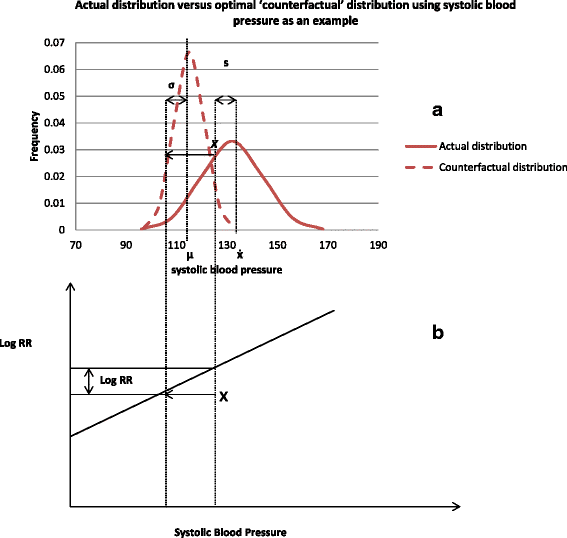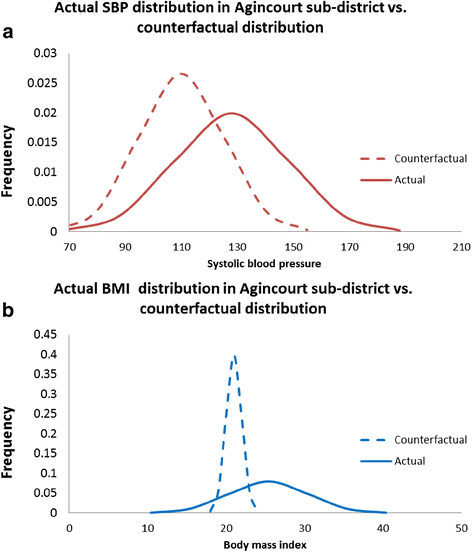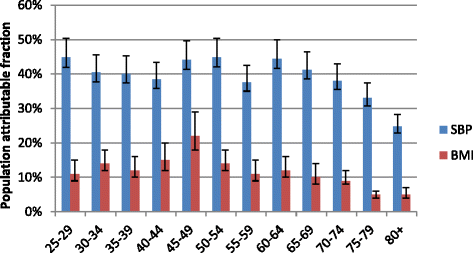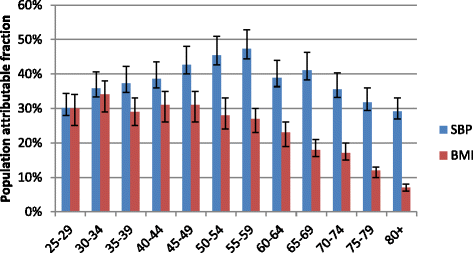Burden of stroke attributable to selected lifestyle risk factors in rural South Africa
- PMID: 26869067
- PMCID: PMC4751665
- DOI: 10.1186/s12889-016-2805-7
Burden of stroke attributable to selected lifestyle risk factors in rural South Africa
Abstract
Background: Rural South Africa (SA) is undergoing a rapid health transition characterized by increases in non-communicable diseases; stroke in particular. Knowledge of the relative contribution of modifiable risk factors on disease occurrence is needed for public health prevention efforts and community-oriented health promotion. Our aim was to estimate the burden of stroke in rural SA that is attributable to high blood pressure, excess weight and high blood glucose using World Health Organization's comparative risk assessment (CRA) framework.
Methods: We estimated current exposure distributions of the risk factors in rural SA using 2010 data from the Agincourt health and demographic surveillance system (HDSS). Relative risks of stroke per unit of exposure were obtained from the Global Burden of Disease Study 2010. We used data from the Agincourt HDSS to estimate age-, sex-, and stroke specific deaths and disability adjusted life years (DALYs). We estimated the proportion of the years of life lost (YLL) and DALY loss attributable to the risk factors and incorporate uncertainty intervals into these estimates.
Results: Overall, 38 % of the documented stroke burden was due to high blood pressure (12 % males; 26 % females). This translated to 520 YLL per year (95 % CI: 325-678) and 540 DALYs (CI: 343-717). Excess Body Mass Index (BMI) was calculated as responsible for 20 % of the stroke burden (3.5 % males; 16 % females). This translated to 260 YLLs (CI: 199-330) and 277 DALYs (CI: 211-350). Burden was disproportionately higher in young females when BMI was assessed.
Conclusions: High blood pressure and excess weight, which both have effective interventions, are responsible for a significant proportion of the stroke burden in rural SA; the burden varies across age and sex sub-groups. The most effective way forward to reduce the stroke burden requires both population wide policies that have an impact across the age spectra and targeted (health promotion/disease prevention) interventions on women and young people.
Figures




Similar articles
-
Disease burden of stroke in rural South Africa: an estimate of incidence, mortality and disability adjusted life years.BMC Neurol. 2015 Apr 12;15:54. doi: 10.1186/s12883-015-0311-7. BMC Neurol. 2015. PMID: 25880843 Free PMC article.
-
Estimating the burden of disease attributable to excess body weight in South Africa in 2000.S Afr Med J. 2007 Aug;97(8 Pt 2):683-90. S Afr Med J. 2007. PMID: 17952225
-
Estimating the changing burden of disease attributable to high body mass index in South Africa for 2000, 2006 and 2012.S Afr Med J. 2022 Sep 30;112(8b):583-593. doi: 10.7196/SAMJ.2022.v112i8b.16488. S Afr Med J. 2022. PMID: 36458354
-
Global burden of disease in young people aged 10-24 years: a systematic analysis.Lancet. 2011 Jun 18;377(9783):2093-102. doi: 10.1016/S0140-6736(11)60512-6. Epub 2011 Jun 7. Lancet. 2011. PMID: 21652063 Review.
-
Theoretical attributable risk analysis and Disability Adjusted Life Years (DALYs) based on increased dairy consumption.BMC Public Health. 2022 Aug 27;22(1):1625. doi: 10.1186/s12889-022-14042-7. BMC Public Health. 2022. PMID: 36030208 Free PMC article. Review.
Cited by
-
Hypertension management in a population of older adults in rural South Africa.J Hypertens. 2017 Jun;35(6):1283-1289. doi: 10.1097/HJH.0000000000001312. J Hypertens. 2017. PMID: 28441697 Free PMC article.
-
Rehabilitation Capacity in South Africa-A Situational Analysis.Int J Environ Res Public Health. 2023 Feb 17;20(4):3579. doi: 10.3390/ijerph20043579. Int J Environ Res Public Health. 2023. PMID: 36834271 Free PMC article.
-
Post stroke health-related quality of life, stroke severity and function: A longitudinal cohort study.Afr J Disabil. 2022 Jan 26;11:947. doi: 10.4102/ajod.v11i0.947. eCollection 2022. Afr J Disabil. 2022. PMID: 35169551 Free PMC article.
-
Stigma and chronic illness: A comparative study of people living with HIV and/or AIDS and people living with hypertension in Limpopo Province, South Africa.Curationis. 2018 Oct 25;41(1):e1-e5. doi: 10.4102/curationis.v41i1.1879. Curationis. 2018. PMID: 30456983 Free PMC article.
-
The Healthy Aging Adult South Africa report card: a systematic review of the evidence between 2013 and 2020 for middle-aged South African men and women.Cardiovasc J Afr. 2022 Jul-Aug 23;33(4):200-219. doi: 10.5830/CVJA-2022-015. Epub 2022 Jul 1. Cardiovasc J Afr. 2022. PMID: 35789240 Free PMC article.
References
-
- Pillay-van Wyk V, Msemburi W, Laubscher R, Dorrington RE, Groenewald P, Matzopoulos R, et al. Second national burden of disease study South Africa: national and subnational mortality trends, 1997–2009. Lancet. 2013;381:S113.
-
- World Health Organization. Global health risks: mortality and burden of disease attributable to selected major risks: World Health Organization; 2009. http://www.who.int/healthinfo/global_burden_disease/GlobalHealthRisks_re.... Accessed 15 Sep 2015.
-
- National Department of Health. Strategic Plan for the Prevention and Control of Non-Communicable Diseases 2013–17. Pretoria; 2013. http://www.hsrc.ac.za/uploads/pageContent/3893/NCDs%20STRAT%20PLAN%20%20.... Accessed 13 Feb 2015.
Publication types
MeSH terms
Substances
Grants and funding
LinkOut - more resources
Full Text Sources
Other Literature Sources
Medical

